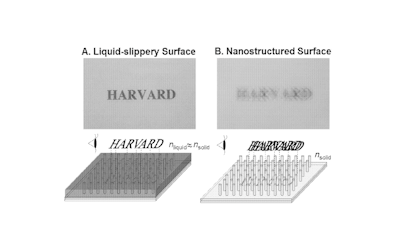Innovations in microbe-binding synthetic protein engineering, slippery surface materials, cell reprogramming and more
To realize its overarching goal to invent and commercialize disruptive solutions for healthcare, energy, architecture, robotics, and manufacturing, the Wyss Institute is creating a patent portfolio in relevant areas that are or can become an essential basis for specific business development and commercialization efforts. To learn more about these innovations, contact our Business Development Team.
The Wyss Institute’s U.S. patents issued between January and December 2015 are as follows:

Engineered opsonin for pathogen detection and treatment
U.S. Patent 9,150,631 (October 6, 2015)
Michael Super, Jeffrey Charles Way, and Donald E. Ingber
Abstract: The present invention provides for engineered molecular opsonins that may be used to bind biological pathogens or identify subclasses or specific pathogen species for use in devices and systems for treatment and diagnosis of patients with infectious diseases, blood-borne infections or sepsis. An aspect of the invention provides for mannose-binding lectin (MBL), which is an abundant natural serum protein that is part of the innate immune system. The ability of this protein lectin to bind to surface molecules on virtually all classes of biopathogens (viruses, bacteria, fungi, protozoans) make engineered forms of MBL extremely useful in diagnosing and treating infectious diseases and sepsis.
Adaptive shading, display and color control
U.S. Patent 9,122,055 (September 1, 2015)
Joanna Aizenberg, Philseok Kim, and Jack Alvarenga
A substrate having a second material on a surface of the substrate or embedded as a layer within the substrate are described. The second material has a different index of refraction and/or stiffness than the substrate so that stretching and unstretching of the substrate and the second material can induce wrinkles in the second material that interacts with light thereby allowing reversible change from a transparent state to an opaque or iridescent state, and vice versa. The present disclosure is useful as a shading system and/or displays.
Slippery surfaces with high pressure stability, optical transparency, and self-healing characteristics
U.S. Patents 9,121,306 and 9,121,307 (September 1, 2015)
Joanna Aizenberg, Michael Aizenberg, Sung Hoon Kang, Tak Sing Wong, and Philseok Kim
Abstract: The present disclosure describes a strategy to create self-healing, slippery liquid-infused porous surfaces (SLIPS). Roughened (e.g., porous) surfaces can be utilized to lock in place a lubricating fluid, referred to herein as Liquid B to repel a wide range of materials, referred to herein as Object A (Solid A or Liquid A). SLIPS outperforms other conventional surfaces in its capability to repel various simple and complex liquids (water, hydrocarbons, crude oil and blood), maintain low-contact-angle hysteresis (<2.5.degree.), quickly restore liquid-repellency after physical damage (within 0.1-1 s), resist ice, microorganisms and insects adhesion, and function at high pressures (up to at least 690 atm). Some exemplary application where SLIPS will be useful include energy-efficient fluid handling and transportation, optical sensing, medicine, and as self-cleaning, and anti-fouling materials operating in extreme environments.

Mutant Cas9 proteins
U.S. Patent 9,074,199 (July 7, 2015)
Alejandro Chavez, Frank Poelwijk, and George M. Church
Abstract: Methods of making mutant Cas9 proteins are described.]
RNA-guided human genome engineering
U.S. Patent 9,023,649 (May 5, 2015)
Prashant G. Mali, George M. Church, and Luhan Yang
Abstract: A method of altering a eukaryotic cell is provided including transfecting the eukaryotic cell with a nucleic acid encoding RNA complementary to genomic DNA of the eukaryotic cell, transfecting the eukaryotic cell with a nucleic acid encoding an enzyme that interacts with the RNA and cleaves the genomic DNA in a site specific manner, wherein the cell expresses the RNA and the enzyme, the RNA binds to complementary genomic DNA and the enzyme cleaves the genomic DNA in a site specific manner.
